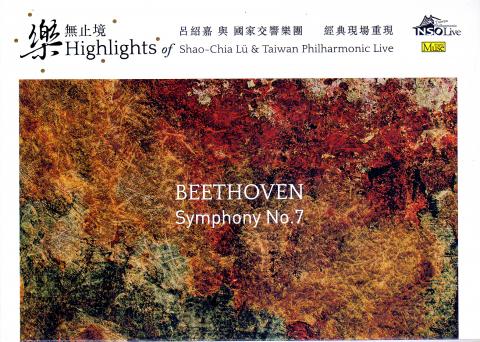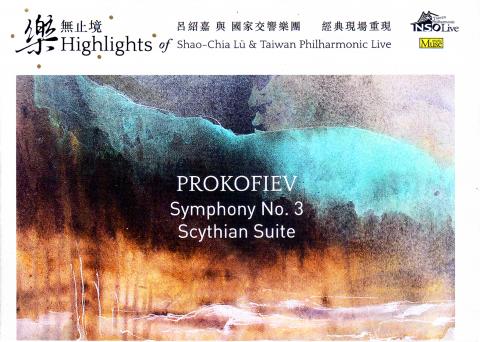BEETHOVEN/ STRAUSS, Symphony No.7, Till Eulenspiegel, Taiwan Philharmonic Live, MU 130002; NSO 022
PROKOFIEV, Symphony No.3, Scythian Suite, Cinderella Suite No.1 (excerpts), Taiwan Philharmonic Live, MU 130003; NSO 023
One of the most ambitious projects of Taiwan’s National Symphony Orchestra (NSO) in recent years has been the 7-CD set Highlights of Shao-Chia Lu & Taiwan Philharmonic Live. In essence, what this boxed set contains is two CDs devoted to music by Oliver Messiaen, with a little Wagner thrown in, a single CD devoted almost equally to Beethoven and Richard Strauss, two CDs devoted to Prokofiev and another two containing French music (by Cesar Franck, Debussy and Ravel).

This is too much music to do justice in a single review, so we will consider it in two parts. Today we will report on the two Prokofiev CDs and the Beethoven/ Richard Strauss CD. Next month we will see what the two CDs devoted to French music, plus the two devoted mostly to Olivier Messiaen (also a French composer) have to offer.
But it’s worth pointing out before we start that the two largely Messiaen CDs are, unlike the other items, not available except as part of the 7-CD boxed set. This is for complex reasons involving the record label. Everyone involved with both the performance and the recording was satisfied with the result, but the product nonetheless remains “For Promotion Only,” and is duly so labeled.
What are we to say about Sergei Prokofiev (1891-1953)? That he was a master modernist, that he was a Russian genius who became influenced by French models, that he combined spectacular innovations with an ability to write lovable melodies in the traditional manner or that he was international in stature but forced to remain in the Soviet Union once he returned there from Paris in 1936?

All or most of these things are probably to some extent true, but his stature is anyway assured. This is illustrated by the decision of the NSO’s music director, Lu Shao-Chia (呂紹嘉), to fill two CDs in the set currently under consideration exclusively with his work.
First comes the Symphony No 3. Its origins lie in the failure of the authorities to approve his opera The Fiery Angel, with its story of a young girl who experienced visions in the Middle Ages and was eventually burned at the stake. Prokofiev responded by using the music for this symphony. The problem with this is that operas last several hours and all the events need to have their musical accompaniment. The symphony, by contrast, has from its earliest times been concise, and involved with meaning. Prokofiev’s eclectic symphony almost inevitably doesn’t have these qualities.
Nevertheless, Maestro Lu’s forces handle their material with consummate mastery. This is by far the most impressive of the Prokofiev performances on these two CDs devoted to the Russian master. The final movement alone is enough to make your hair stand on end. Unfortunately, the entire work was somewhat undermined when The Fiery Angel was finally staged a year after the composer’s death.
Next we have excerpts from the Cinderella Suite No 1, a concert version of some of the composer’s hugely successful ballet music for that story. I found this rather underwhelming, possibly because the ballet when heard complete is so very touching and memorable.
When Prokofiev’s Scythian Suite was first performed in January 1916 it was greeted with howls of derision. The Scythians were a nomadic people who flourished 2,000 years ago and more north of the Black Sea. They were known to the ancient Greeks and to the Chinese. The general view has been that they were sun-worshipping barbarians given to the excessive consumption of cannabis, a perception reflected in this music.
Prokofiev initially began writing it as a ballet for the Ballet Russes, but their impresario Diaghilev, who initially wanted something as a follow-up to Stravinski’s equally savage Rite of Spring, rejected it before it was even finished. Prokofiev, once again the opportunist par excellence, shrugged his shoulders and turned what he’d completed into this orchestral suite lasting around 20 minutes.
By and large, the work seems to me to have been overpraised. An American critic wrote in 1925 that its closing movement was “like nothing else in the literature of music.” Yet even the Rite of Spring itself, which Prokofiev had heard in Paris, exceeds it in just the ambiance it aims to exemplify. Perhaps Diaghilev knew what he was doing and decided against an imitation of a famous success, opting instead for something genuinely new. The performance here is appropriately energetic, needless to say, but the work itself doesn’t even equal the Third Symphony, let alone the full Cinderella music.
We are left with the recordings of Richard Strauss’s Till Eulenspiegel and Beethoven’s 7th Symphony. It has to be said at once that this performance of the Strauss tone-poem is an absolute masterpiece. Rarely has any orchestra in my experience sounded so tinsel-bright, so sonorous and so endlessly zestful.
We expressed the belief in March that Strauss must surely be very close to Maestro Lu’s heart, and this superlative performance again confirms the suspicion. The Beethoven, by contrast, sounds relatively run of the mill, but maybe my own preference (overwhelmingly pro-Strauss) influences my judgment here.
For your information:
These CDs can be purchased on the following Web sites, or at any NSO concert (where they are cheaper than these online stores):
■ www.books.com.tw/exep/cdfile.php?item=0020176394
■ www.pcstore.com.tw/miami/M15467969.htm
■ www.5music.com.tw/ListArt.asp?art=434495679302&mut=D
■ www.eslite.com/product.aspx?pgid=1004262342295877

Dec. 16 to Dec. 22 Growing up in the 1930s, Huang Lin Yu-feng (黃林玉鳳) often used the “fragrance machine” at Ximen Market (西門市場) so that she could go shopping while smelling nice. The contraption, about the size of a photo booth, sprayed perfume for a coin or two and was one of the trendy bazaar’s cutting-edge features. Known today as the Red House (西門紅樓), the market also boasted the coldest fridges, and offered delivery service late into the night during peak summer hours. The most fashionable goods from Japan, Europe and the US were found here, and it buzzed with activity

During the Japanese colonial era, remote mountain villages were almost exclusively populated by indigenous residents. Deep in the mountains of Chiayi County, however, was a settlement of Hakka families who braved the harsh living conditions and relative isolation to eke out a living processing camphor. As the industry declined, the village’s homes and offices were abandoned one by one, leaving us with a glimpse of a lifestyle that no longer exists. Even today, it takes between four and six hours to walk in to Baisyue Village (白雪村), and the village is so far up in the Chiayi mountains that it’s actually

These days, CJ Chen (陳崇仁) can be found driving a taxi in and around Hualien. As a way to earn a living, it’s not his first choice. He’d rather be taking tourists to the region’s attractions, but after a 7.4-magnitude earthquake struck the region on April 3, demand for driver-guides collapsed. In the eight months since the quake, the number of overseas tourists visiting Hualien has declined by “at least 90 percent, because most of them come for Taroko Gorge, not for the east coast or the East Longitudinal Valley,” he says. Chen estimates the drop in domestic sightseers after the

US Indo-Pacific Commander Admiral Samuel Paparo, speaking at the Reagan Defense Forum last week, said the US is confident it can defeat the People’s Republic of China (PRC) in the Pacific, though its advantage is shrinking. Paparo warned that the PRC might launch a “war of necessity” even if it thinks it could not win, a wise observation. As I write, the PRC is carrying out naval and air exercises off its coast that are aimed at Taiwan and other nations threatened by PRC expansionism. A local defense official said that China’s military activity on Monday formed two “walls” east